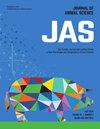Supplemental effects of acidifier and encapsulated butyrate solely and combined in high canola meal diets for nursery pigs
IF 2.7
2区 农林科学
Q1 AGRICULTURE, DAIRY & ANIMAL SCIENCE
引用次数: 0
Abstract
Incorporating canola meal (CM) into nursery pig diets has been limited due to the adverse effects of glucosinolates—sulfur-containing glycosides presented in Brassica family oilseeds. This study investigated the effects of acidifiers supplementation in high CM diets on the performance, organ weights, blood profiles, and hindgut microbial composition of nursery pigs. A total of 315 nursery pigs, average 6.0 ± 1.2 kg body weight (BW), were assigned to one of five dietary treatments with 9 replicates (7 pigs/pen) in a randomized complete block design. Treatments included; a corn-soybean meal (SBM) based diet with 20% CM (PC) and corn-SBM based diet with 40% CM without (NC) or with acidifier (NCA), or encapsulated butyrate (NCB), or both (NCAB). Diets met nutrient requirement of NRC (2012) in three phases; Phase 1 (common diet; 0-1 weeks), Phase 2 (experimental diets; 1-3 weeks), and Phase 3 (experimental diets; 3-6 weeks). Pig BW and pen feed consumption were measured by phase to investigate the growth performance of pigs. At the end of each phase, one pig per pen was bled and then euthanized for measurement of organ weight. Cecal digesta was collected only at the end of Phase 3 for microbial composition analysis. Pigs fed the NCA diets had greater (P < 0.05) final BW and average daily gain during Phase 3 and had a tendency of greater (P = 0.084) overall gain-to-feed ratio than pigs fed the NC diet. Pigs fed the NCA diet had a greater (χ2 < 0.05) percentage of non-diarrhea feces than pigs fed the PC diet for Phase 2 and overall period. Pigs fed PC diet had higher serum thyroxine (T4) concentration at the end of Phase 3 (P < 0.05) than pigs fed NC diets. Addition of acidifier in NC diet decreased (P < 0.05) spleen weight and tended to decrease (P = 0.064) liver weight. Pigs fed the NCAB diet had a lower (P < 0.05) large intestine weight compared with those fed NC diet. Pigs fed the PC or NCA diets tended to have less (P = 0.06) the relative abundance of OTU Ssd-00188 (Agathobacter rectalis 99.23%) and NCAB diet increased (P < 0.05) the relative abundance of OTU Ssd-00001 (Lactobacillus amylovorus 99.64%) in the cecal microbiota compared with those fed NC diet. Overall, these findings support the incorporation of high CM levels (up to 40%) with acidifier supplementation in nursery pig diets, mitigating the negative implications of dietary glucosinolates and providing benefits for both canola growers and pig farmers in regions with substantial canola production.在高菜籽粕日粮中单独或联合使用酸化剂和封装丁酸盐对保育猪的补充效果
由于芸苔属油菜籽中的葡萄糖苷酸盐(含硫苷)的不利影响,在保育猪日粮中添加菜籽粕(CM)一直受到限制。本研究调查了在高 CM 日粮中添加酸化剂对育肥猪的生产性能、器官重量、血液指标和后肠微生物组成的影响。在随机完全区组设计中,共有 315 头平均体重为 6.0 ± 1.2 千克(BW)的育肥猪被分配到五种日粮处理中的一种,共设 9 个重复(每栏 7 头猪)。处理包括:以玉米-大豆粉(SBM)为基础、含 20% CM 的日粮(PC),以及以玉米-SBM 为基础、含 40% CM 的日粮,其中不含酸化剂(NC)或含酸化剂(NCA),或封装丁酸盐(NCB),或两者兼有(NCAB)。日粮在三个阶段均符合 NRC(2012)的营养要求:第 1 阶段(普通日粮;0-1 周)、第 2 阶段(实验日粮;1-3 周)和第 3 阶段(实验日粮;3-6 周)。分阶段测量猪的体重和栏内饲料消耗量,以调查猪的生长性能。在每个阶段结束时,对每栏一头猪进行放血,然后安乐死,以测量器官重量。仅在第 3 阶段结束时收集盲肠消化物,用于微生物成分分析。与饲喂 NC 日粮的猪相比,饲喂 NCA 日粮的猪在第 3 阶段的最终体重和平均日增重更高(P < 0.05),总体增重-饲料比也有更高的趋势(P = 0.084)。与饲喂 PC 日粮的猪相比,饲喂 NCA 日粮的猪在第 2 阶段和整个阶段的非腹泻粪便百分比更高 (χ2 < 0.05)。与饲喂 NC 日粮的猪相比,饲喂 PC 日粮的猪在第 3 阶段结束时血清甲状腺素(T4)浓度更高(P < 0.05)。在 NC 日粮中添加酸化剂会降低(P < 0.05)脾脏重量,并有降低(P = 0.064)肝脏重量的趋势。与饲喂 NC 日粮的猪相比,饲喂 NCAB 日粮的猪大肠重量较低(P & lt; 0.05)。与饲喂 NC 日粮的猪相比,饲喂 PC 或 NCA 日粮的猪在盲肠微生物群中 OTU Ssd-00188(直肠农杆菌 99.23%)的相对丰度较低(P = 0.06),饲喂 NCAB 日粮的猪在盲肠微生物群中 OTU Ssd-00001(淀粉乳杆菌 99.64%)的相对丰度较高(P < 0.05)。总之,这些研究结果支持在保育猪日粮中添加高浓度 CM(高达 40%)的酸化剂,以减轻日粮中葡萄糖苷酸盐的负面影响,并为油菜籽种植者和大量生产油菜籽地区的养猪户带来益处。
本文章由计算机程序翻译,如有差异,请以英文原文为准。
求助全文
约1分钟内获得全文
求助全文
来源期刊

Journal of animal science
农林科学-奶制品与动物科学
CiteScore
4.80
自引率
12.10%
发文量
1589
审稿时长
3 months
期刊介绍:
The Journal of Animal Science (JAS) is the premier journal for animal science and serves as the leading source of new knowledge and perspective in this area. JAS publishes more than 500 fully reviewed research articles, invited reviews, technical notes, and letters to the editor each year.
Articles published in JAS encompass a broad range of research topics in animal production and fundamental aspects of genetics, nutrition, physiology, and preparation and utilization of animal products. Articles typically report research with beef cattle, companion animals, goats, horses, pigs, and sheep; however, studies involving other farm animals, aquatic and wildlife species, and laboratory animal species that address fundamental questions related to livestock and companion animal biology will be considered for publication.
 求助内容:
求助内容: 应助结果提醒方式:
应助结果提醒方式:


